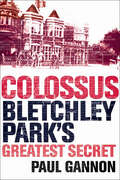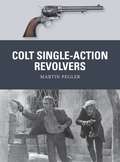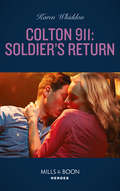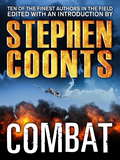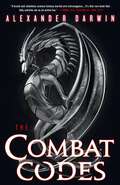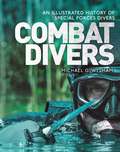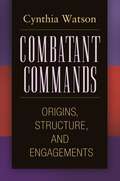- Table View
- List View
Colorado Women in World War II (Timberline Books)
by Gail M. BeatonFour months before the attack on Pearl Harbor on December 7, 1941, Mildred McClellan Melville, a member of the Denver Woman’s Press Club, predicted that war would come for the United States and that its long arm would reach into the lives of all Americans. And reach it did. Colorado women from every corner of the state enlisted in the military, joined the workforce, and volunteered on the home front. As military women, they served as nurses and in hundreds of noncombat positions. In defense plants they riveted steel, made bullets, inspected bombs, operated cranes, and stored projectiles. They hosted USO canteens, nursed in civilian hospitals, donated blood, drove Red Cross vehicles, and led scrap drives; and they processed hundreds of thousands of forms and reports. Whether or not they worked outside the home, they wholeheartedly participated in a kaleidoscope of activities to support the war effort. In Colorado Women in World War II Gail M. Beaton interweaves nearly eighty oral histories—including interviews, historical studies, newspaper accounts, and organizational records—and historical photographs (many from the interviewees themselves) to shed light on women’s participation in the war, exploring the dangers and triumphs they felt, the nature of their work, and the lasting ways in which the war influenced their lives. Beaton offers a new perspective on World War II—views from field hospitals, small steel companies, ammunition plants, college classrooms, and sugar beet fields—giving a rare look at how the war profoundly transformed the women of this state and will be a compelling new resource for readers, scholars, and students interested in Colorado history and women’s roles in World War II.
Colossus: Bletchley Park's Greatest Secret
by Paul GannonThis is the last untold story of Bletchley Park. Using declassified information, Paul Gannon gives us a gripping account of the invention of the world's first true computer, Colossus.Uncover the secrets of Bletchley Park's code-breaking computers.In 1940, almost a year after the outbreak of the Second World war, Allied radio operators at an interception station in South London began picking up messages in a strange new code. Using science, maths, innovation and improvisation Bletchley Park codebreakers worked furiously to invent a machine to decipher what turned out to be the secrets of Nazi high command. It was called Colossus.What these codebreakers didn't realize was that they had to fashion the world's first true computer. When the war ended, this incredible invention was dismantled and hidden away for almost 50 years. Paul Gannon has pieced together the tremendous story of what is now recognized as the greatest secret of Bletchley Park.'Gannon's book contains a mass of utterly fascinating and largely unknown material about an immensely important wartime project, and is very welcome indeed.' - Brian Rendell, TES
The Colours
by Juliet BatesEllen sees the world differently from everyone else, but living in a tiny town in the north-east of England, in a world on the cusp of war, no one has time for an orphaned girl who seems a little strange. When she is taken in to look after a rich, elderly widow all seems to be going better, despite the musty curtains and her aging employer completely out of touch with the world. But pregnancy out of wedlock spoils all this, and Ellen is unable to cope. How will Jack, her son, survive - alone in the world as his mother was? Can they eventually find their way back to each other?The Colours is a sweeping novel of how we can lose ourselves, and our loved ones, for fans of Kate Atkinson and Virginia Baily.
The Colt 1911 Pistol (Weapon)
by Peter Dennis Leroy Thompson Alan GillilandFirst used in combat during the Punitive Expedition into Mexico and then extensively during the world wars, the Colt Government Model (1911) pistol remained the standard issue handgun in the US armed forces for nearly 80 years and has continued in service with some units to this day. In fact, the M1911 has seen a resurgence amongst US Special Operations units as US Marine MARSOC and MEUSOC personnel are issued current generation 1911-type pistols. In addition the pistol has seen service with famous law enforcement agencies such as the Shanghai Municipal Police, LAPD Swat and Texas Rangers. Nearly a century after its introduction, the M1911 pistol remains a popular design and is now produced by virtually every major firearms manufacturer doing business in the USA.
The Colt 1911 Pistol (Weapon #9)
by Peter Dennis Leroy Thompson Alan GillilandFirst used in combat during the Punitive Expedition into Mexico and then extensively during the world wars, the Colt Government Model (1911) pistol remained the standard issue handgun in the US armed forces for nearly 80 years and has continued in service with some units to this day. In fact, the M1911 has seen a resurgence amongst US Special Operations units as US Marine MARSOC and MEUSOC personnel are issued current generation 1911-type pistols. In addition the pistol has seen service with famous law enforcement agencies such as the Shanghai Municipal Police, LAPD Swat and Texas Rangers. Nearly a century after its introduction, the M1911 pistol remains a popular design and is now produced by virtually every major firearms manufacturer doing business in the USA.
Colt Single-Action Revolvers (Weapon #52)
by Martin Pegler Alan Gilliland Mr Mark StaceyIn 1836, Samuel Colt changed the face of warfare with the production of the first of a series of iconic and influential single-action revolvers, including the .44-calibre Colt Walker and the seminal .45-calibre Colt Single Action Army, which remains in production today. These weapons shifted the role of the pistol from single-shot weapon of last resort to a practical and powerful sidearm that gave the user the ability to defend himself once his primary armament was discharged. It transformed cavalry tactics and relegated the sword to a largely ceremonial role in many armies.Featuring full-colour artwork, expert analysis and gripping first-hand accounts, this is the absorbing story of Colt's family of single-action revolvers, covering their origins, development, use and lasting impact on the modern world.
Colt Single-Action Revolvers (Weapon)
by Martin Pegler Mark Stacey Alan GillilandIn 1836, Samuel Colt changed the face of warfare with the production of the first of a series of iconic and influential single-action revolvers, including the .44-calibre Colt Walker and the seminal .45-calibre Colt Single Action Army, which remains in production today. These weapons shifted the role of the pistol from single-shot weapon of last resort to a practical and powerful sidearm that gave the user the ability to defend himself once his primary armament was discharged. It transformed cavalry tactics and relegated the sword to a largely ceremonial role in many armies.Featuring full-colour artwork, expert analysis and gripping first-hand accounts, this is the absorbing story of Colt's family of single-action revolvers, covering their origins, development, use and lasting impact on the modern world.
Colton 911: Last Stand Sheriff (winding Road Redemption) / Colton 911: Detective On Call (colton 911: Grand Rapids) (Colton 911: Grand Rapids #3)
by Regan BlackTwo bitter rivals unite to track a deadly killer
Colton 911: Dangerous Knowledge (fortress Defense) / Colton 911: In Hot Pursuit (colton 911: Grand Rapids) (Colton 911: Grand Rapids #5)
by Geri KrotowOn the run for their lives…and straight towards a killer
Colton 911: Protecting His Witness (heartland Heroes) / Colton 911: Soldier's Return (colton 911: Chicago) (Colton 911: Chicago #4)
by Karen WhiddonHe’s putting his heart on the line for love
Colton 911: Secret Defender (Colton 911: Chicago #7)
by Marie FerrarellaA former boxer must KO the threat to her life
Combat: 18-copy Mass Market Mixed Floor Display (Stephen Coonts' Combat Ser. #1)
by Stephen CoontsCombat brings the best military fiction authors together to imagine how war will be fought in the twenty-first century. From the down and dirty 'ground-pounders' of the U.S. Armored Cavalry to new frontiers of warfare, including outer space and cyber warfare, ten authors whose novels define the military fiction genre have written short stories that also celebrate the men and women who put their lives on the line for freedom.
The Combat Codes (The Combat Codes #1)
by Alexander DarwinHundreds of years ago on a planet once ravaged by war, the nations swore an armistice never to use weapons of mass destruction again. Today, battle-hardened warriors known as Grievar Knights train to represent their nations' interests in brutal hand-to-hand combat. Murray Pearson was once a famed Knight until he suffered a loss that crippled his nation - but now he's on the hunt to find and train the next champion.Below, in the Underground's brutal combat rings, an orphaned boy called Cego is making a name for himself. Murray believes he has what it takes to make it in the planet's most prestigious combat school - but he has to fight his way out of the Underground first.
Combat Divers: An illustrated history of special forces divers
by Michael G. WelhamThe full visual history of the special forces combat diver from World War II to the present day.Combat divers are an elite within an elite. Every special forces combat diver is required to pass selection twice – first into the elite military unit and then a combat diving qualification. The combat dive units themselves are tiny and the operations highly classified. The role of a military diver is inevitably a lonely and a dangerous one, whether clearing mines or striking from the sea against enemy-held targets. Fully illustrated with rare and unusual images, Combat Divers reveals their little-known yet fascinating operations, from Dutch Special Forces combat divers covertly operating against Somali pirates to the actions of Soviet Spetsnaz divers in Swedish territorial waters during the Cold War. It also examines how the most famous units, such as the US Navy SEALs and the Royal Navy's SBS, are currently operating and adapting to threats in a multitude of theatres. Combat Divers gives an insight into specialist kit and vehicles presently used and equipment that is being developed and trialed throughout the world. Covering a variety of kit, from dry deck shelters to mini-submarines and swimmer delivery vehicles, former Royal Marines Commando Michael G. Welham draws on his own extensive diving experience to reveal exactly how this equipment is used by special forces dive teams. As their kit and equipment constantly evolve, so does the nature of their work and even the team element. Combat Divers also details the first female combat divers and includes their own first-hand accounts about their groundbreaking roles within their respective units to create a fascinating history of these elite special forces operatives.
Combat Divers: An illustrated history of special forces divers
by Michael G. WelhamThe full visual history of the special forces combat diver from World War II to the present day.Combat divers are an elite within an elite. Every special forces combat diver is required to pass selection twice – first into the elite military unit and then a combat diving qualification. The combat dive units themselves are tiny and the operations highly classified. The role of a military diver is inevitably a lonely and a dangerous one, whether clearing mines or striking from the sea against enemy-held targets. Fully illustrated with rare and unusual images, Combat Divers reveals their little-known yet fascinating operations, from Dutch Special Forces combat divers covertly operating against Somali pirates to the actions of Soviet Spetsnaz divers in Swedish territorial waters during the Cold War. It also examines how the most famous units, such as the US Navy SEALs and the Royal Navy's SBS, are currently operating and adapting to threats in a multitude of theatres. Combat Divers gives an insight into specialist kit and vehicles presently used and equipment that is being developed and trialed throughout the world. Covering a variety of kit, from dry deck shelters to mini-submarines and swimmer delivery vehicles, former Royal Marines Commando Michael G. Welham draws on his own extensive diving experience to reveal exactly how this equipment is used by special forces dive teams. As their kit and equipment constantly evolve, so does the nature of their work and even the team element. Combat Divers also details the first female combat divers and includes their own first-hand accounts about their groundbreaking roles within their respective units to create a fascinating history of these elite special forces operatives.
Combat Machines: The Executioner
by Don PendletonKILLER OFFENSIVE One by one, European leaders are dying by assassination. And each of the victims opposed Russia's attempts to gain increasing power. Determined to stop this wave of terror before it hits American shores, Mack Bolan uses the killers' next attack to flush them out. But these assassins are inhumanly fast, impervious to pain and programmed with cutting-edge combat skills by a hard-line Soviet scientist. Now Bolan is being shadowed by a ruthless Russian intelligence team racing to bury him along with this rogue military project. To save a summit of world leaders, the Executioner must play two brutal factions against each otherand send the assassins' creator to meet his maker.
The Combat Soldier: Infantry Tactics And Cohesion In The Twentieth And Twenty-first Centuries
by Anthony KingHow do small groups of combat soldiers maintain their cohesion under fire? This question has long intrigued social scientists, military historians, and philosophers. Based on extensive research and drawing on graphic analysis of close quarter combat from the Somme to Sangin, the book puts forward a novel and challenging answer to this question. Against the common presumption of the virtues of the citizen soldier, this book claims that, in fact, the infantry platoon of the mass twentieth century army typically performed poorly and demonstrated low levels of cohesion in combat. With inadequate time and resources to train their troops for the industrial battlefield, citizen armies typically relied on appeals to masculinity, nationalism and ethnicity to unite their troops and to encourage them to fight. By contrast, cohesion among today's professional soldiers is generated and sustained quite differently. While concepts of masculinity and patriotism are not wholly irrelevant, the combat performance of professional soldiers is based primarily on drills which are inculcated through intense training regimes. Consequently, the infantry platoon has become a highly skilled team capable of collective virtuosity in combat. The increasing importance of training, competence and drills to the professional infantry soldier has not only changed the character of cohesion in the twenty-first century platoon but it has also allowed for a wider social membership of this group. Soldiers are no longer included or excluded into the platoon on the basis of their skin colour, ethnicity, social background, sexuality or even sex (women are increasingly being included in the infantry) but their professional competence alone: can they do the job? In this way, the book traces a profound transformation in the western way of warfare to shed light on wider processes of transformation in civilian society. This book is a project of the Oxford Programme on the Changing Character of War.
Combat Stress in Pre-modern Europe (Mental Health in Historical Perspective)
by Owen Rees Kathryn Hurlock Jason CrowleyThis book examines the lasting impact of war on individuals and their communities in pre-modern Europe. Research on combat stress in the modern era regularly draws upon the past for inspiration and validation, but to date no single volume has effectively scrutinised the universal nature of combat stress and its associated modern diagnoses. Highlighting the methodological obstacles of using modern medical and psychological models to understand pre-modern experiences, this book challenges existing studies and presents innovative new directions for future research. With cutting-edge contributions from experts in history, classics and medical humanities, the collection has a broad chronological focus, covering periods from Archaic Greece (c. sixth and early fifth century BCE) to the British Civil Wars (seventeenth century CE). Topics range from the methodological, such as the dangers of retrospective diagnosis and the applicability of Moral Injury to the past, to the conventionally historical, examining how combat stress and post-traumatic stress disorder may or may not have manifested in different time periods. With chapters focusing on combatants, women, children and the collective trauma of their communities, this collection will be of great interest to those researching the history of mental health in the pre-modern period.
Combat Stress Injury: Theory, Research, and Management (Psychosocial Stress Series)
by Charles R. Figley William P. NashCombat Stress Injury represents a definitive collection of the most current theory, research, and practice in the area of combat and operational stress management, edited by two experts in the field. In this book, Charles Figley and Bill Nash have assembled a wide-ranging group of authors (military / nonmilitary, American / international, combat veterans / trainers, and as diverse as psychiatrists / psychologists / social workers / nurses / clergy / physiologists / military scientists). The chapters in this volume collectively demonstrate that combat stress can effectively be managed through prevention and training prior to combat, stress reduction methods during operations, and desensitization programs immediately following combat exposure.
Combat Stress Injury: Theory, Research, and Management (Psychosocial Stress Series)
by Charles R. Figley William P. NashCombat Stress Injury represents a definitive collection of the most current theory, research, and practice in the area of combat and operational stress management, edited by two experts in the field. In this book, Charles Figley and Bill Nash have assembled a wide-ranging group of authors (military / nonmilitary, American / international, combat veterans / trainers, and as diverse as psychiatrists / psychologists / social workers / nurses / clergy / physiologists / military scientists). The chapters in this volume collectively demonstrate that combat stress can effectively be managed through prevention and training prior to combat, stress reduction methods during operations, and desensitization programs immediately following combat exposure.
Combatant Commands: Origins, Structure, and Engagements (Praeger Security International)
by Cynthia A. WatsonA one-stop resource for information about U.S. military commands and their organizations, this book describes the six geographic combat commands and analyzes their contributions to national security.The first book on the topic, Combatant Commands: Origins, Structure, and Engagements is a unique introduction to the geographic commands that are now at the heart of the U.S. military deployment abroad. The book begins with a description of the six commands—Northern Command, Pacific Command, Central Command, Southern Command, European Command, and Africa Command—explaining how they fit into the current national security establishment. Each command is discussed in depth, including areas of responsibility, subcommands, priorities, threats faced, and engagement institutions.The history of joint combatant commands is outlined as well, particularly the impact of the Root Reforms of the early 20th century, the push for the 1947 National Security Act, and the 1986 Goldwater-Nichols Military Reform Act. In this way, the evolution of combatant commands becomes a window through which to view changes in the U.S. military. Geographic combatant commands are vital to national security. By understanding how they work, readers will better understand where our military is today and where it may be headed.
Combatant Commands: Origins, Structure, and Engagements (Praeger Security International)
by Cynthia A. WatsonA one-stop resource for information about U.S. military commands and their organizations, this book describes the six geographic combat commands and analyzes their contributions to national security.The first book on the topic, Combatant Commands: Origins, Structure, and Engagements is a unique introduction to the geographic commands that are now at the heart of the U.S. military deployment abroad. The book begins with a description of the six commands—Northern Command, Pacific Command, Central Command, Southern Command, European Command, and Africa Command—explaining how they fit into the current national security establishment. Each command is discussed in depth, including areas of responsibility, subcommands, priorities, threats faced, and engagement institutions.The history of joint combatant commands is outlined as well, particularly the impact of the Root Reforms of the early 20th century, the push for the 1947 National Security Act, and the 1986 Goldwater-Nichols Military Reform Act. In this way, the evolution of combatant commands becomes a window through which to view changes in the U.S. military. Geographic combatant commands are vital to national security. By understanding how they work, readers will better understand where our military is today and where it may be headed.


